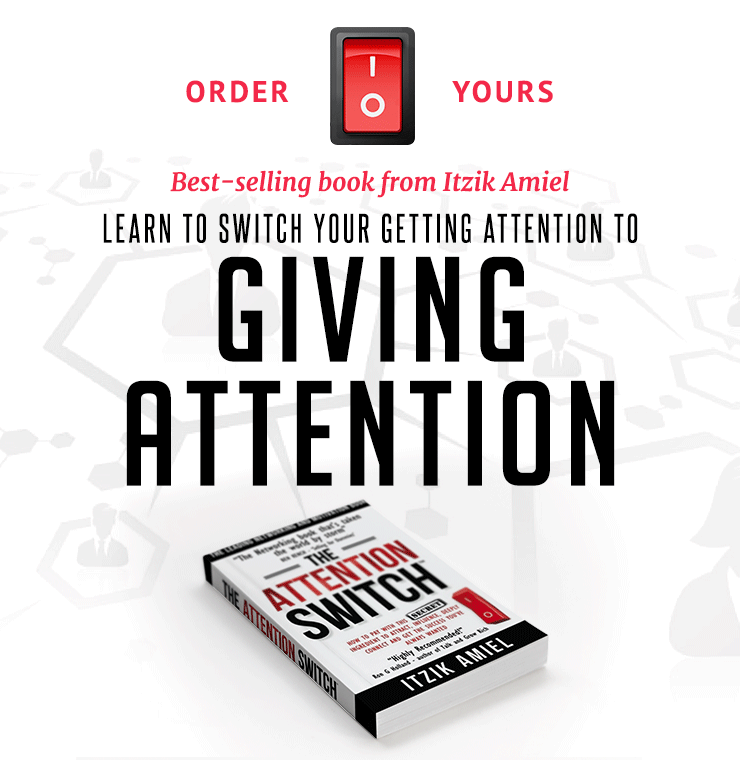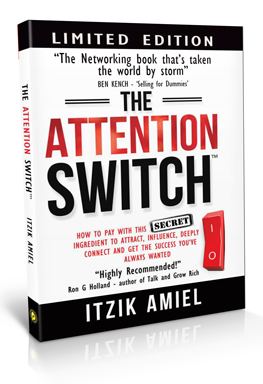By: Itzik Amiel, Bestselling Author of ‘The Attention Switch’; Founder & CEO, Power Networking Academy & Michael Soto, Co-Founder of Spark Collaboration
Did you ever think that the way you approach people will make or break the kind of relationships you will develop with these people?
Over the years we’ve each developed quite an extensive network. In order to meet new people, we have to actually approach and speak to them, which can be really nerve-wracking.
Naturally, the first impression is very important, but can you control it? Can you influence the way others react to you by your way of approaching them? How much the character of the other person matter for your way of approaching them?
We have no doubt that having the ability to be comfortable in approaching new people – total strangers – is an important skill to develop.
This skill can accelerate the growth of your network and build your relations capital. This skill will expand your social circle and create for you new and interesting opportunities to get new knowledge, to get advanced in your career etc.
Over the years, and by building our own relations capital globally, we’ve come across two main ways of approaching people.
The first method to relationship building is to approach meetings with broader intentions. The second is to approach meetings with narrower intentions.
In this post, we’ll explain what we mean by each approach to meetings and provide insight into the pros and cons of each.
This is important to keep in mind whenever you are planning to reach out to a new person. It is also helpful to keep in mind when someone has asked to set up a meeting with you.
METHOD #1: NARROWER INTENTIONS
Most people seem to prefer the narrower, more specific, intention approach.
When meeting someone new, these people prefer to have a very clear “ask.” This is actually also the common piece of advice in sales circles.
Similarly, when approached by someone new, these people are often asking themselves in the background, “What does this person want from me?”
For these people, not having a specific intention when meeting others may be seen as a waste of time (even for both parties).
Really?
We disagree entirely, instead, we argue that the broader intention approach is often much more fruitful and in unexpected ways.
Note: we are not suggesting you talk wildly and open with every person, in every circumstance in any time.
The following approach will help you make the most out of meeting new people.
Remember the cliche, be careful what you ask for, as you might just get it.
METHOD #2: BROADER INTENTIONS
Approaching a person with broader intentions might mean simply saying,
“I have seen you do X very well and I would really like to learn more.”
It is an open ended request, that can be responded in different ways.
By contrast, a narrower intention would be more along the lines of
“I am looking for a job in Y, are you hiring?”
Or,
“I am looking for a business partner with expertise in Z, would you be interested?”
Note that even when approaching with broader intentions, it is still useful to be specific as to why you have reached out to them. This shows that you have put thought into why you would like to meet with them. You prepared and gave them your genuine attention.
This shows that you have put thought into why you would like to meet with them. You prepared and gave them your genuine attention.
However, this does not need to limit the conversation when you meet.
Let’s walk through two scenarios, to demonstrate our approach.
SCENARIO 1: BROADER INTENTIONS
By starting broadly, we start with the full 100% of possible topics. During the course of the conversation, we may find a topic or project of interest. At this point, we then dive into that and focus 10%.
This leaves the remaining 90% of topics and projects for next time. The initial exchange has thereby laid the groundwork for future conversation and for future possibilities to continue building the relationship with this person.
In other words, your time and efforts were not a waste!
SCENARIO 2: NARROWER INTENTIONS
By starting narrowly, we have jumped straight to the 10% we thought would be valuable.
We have not allowed for other conversation to emerge, and have therefore missed a huge opportunity for setting the foundation for the future.
With a narrower approach, the person can respond either positively or negatively. If they respond positively we have received what we are looking for, but nothing more.
If they respond negatively (or even with not much interest), we can not know what else would have been of mutual interest to discuss.
In an attempt to be efficient, we have lost out big on what could have been.
We put in danger the opportunity to develop the relationship for a lifetime. Some may even argue that we build relations that build on narrow interests.
MISMATCH IN APPROACH STYLES
So probably you are asking what if each individual (you and the other person you’re approaching) has different styles and preferences.
Two individuals who have the same approach towards meetings will get along well, because they expect the same thing from the meeting. However, when there is a mismatch an adjustment may be necessary.
If you approach someone narrowly (and they prefer to be approached with broader intentions), it is unlikely that the conversation will extend beyond this narrow focus.
On the contrary, if you approach someone broadly (and they prefer to be approached with narrower intentions), they are likely to give you a second chance by asking for more clarity on what you are looking for and help you to narrow your request.
Some food for thought!
Last Word
Opportunities emerge through the process of getting to know each other and are not often identifiable beforehand.
So asking from the outset narrowly for a specific intention may fail, but it may have indirectly emerged from a broader conversation.
Furthermore, in a meeting where someone only goes in asking for a very specific thing, it is likely that they will miss out on a whole set of opportunities due to the horse blinders which only direct the conversation towards this specific thing.
That is why we recommend starting meetings with broad intentions, it leaves open the possibility for unexpected discoveries by recognizing that we each have much more to offer each other than first meets the eye.
Do you agree? What is your style of communication with others – is it narrow or broad? Or maybe a mix of both? Please share.

“Itzik is an International Speaker, Bestselling Author, Business Mentor & Attorney-at-law. The Global Leading Authority on Business Development, Business Networking, Referrals & Relationship Capital & Founder of THE SWITCH® and THE SWITCH HUB®”





